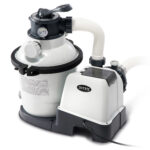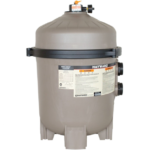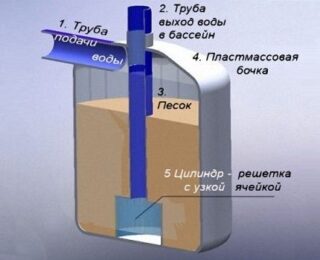The quality of the pool water is ensured by filtration. A cost-effective and efficient way to solve the problems of supplying clean liquid to city-wide and private artificial reservoirs. The owners of the plots make a filter for the pool with their own hands to ensure the quality of cleaning, the reliability of the device. The mechanical method removes insoluble particles from the water.
Types of filters for outdoor pools
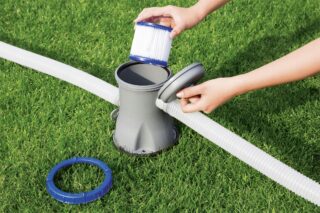
The preparation of the aquatic environment in artificial reservoirs includes the creation of a good-quality liquid from the standpoint of hygiene and safety. Filtration destroys viruses, bacteria and other microorganisms. The unit cleans the liquid mechanically, in contrast to the use of chemical water care products.
Purifiers differ in performance, size, these indicators are chosen depending on the volume of the pool. The form and system of work for filters is also different. Modern developments in the professional cleaning field make it possible to create devices that capture even microscopic particles.
Disposable cartridge
The models are applicable for inflatable and frame plastic reservoirs, while the installations retain pollution over 10 microns. In small volumes (up to three cubes), the cartridges work efficiently, but more water leads to the need for regular cleaning.
The advantage is that such installations do not need to be connected to the sewer network.
Sand pumping stations
The models are most common in commercial and private artificial reservoirs. Allows you to control particles from 1 to 35 microns, depending on the material of the backfill. Glass mass or quartz sand is used.
They are selected in terms of power so that the entire volume of liquid in the pool can pass through the filter in 4 to 8 hours. A pump is sold in the kit.
Diatomaceous (earth)
They occupy the first place in terms of the degree of trapping of contaminants, since they retain elements of 1 - 5 microns. Diatomaceous soil acts as a filtering agent.
The devices are intended for use in private environments.
With low productivity, water installations are distinguished by high-quality filtration. They are expensive, consume a large volume of filter media.
Underwater vacuum cleaners for cleaning the pool
Hand clippers are cheap cleaning options. The design includes a extendable lengthwise handle, a brush and a hose. The electric drive is above the water during the dive.
Semi-automatic units move along the bottom, passing water through the body for cleaning. The route of movement is programmed in advance.
Automatic robots are immersed along with the electrical part, they also pass along the bottom. Equipped with remote controls for remote control.
Features of Sand Filter Pump
The impervious body is made of plastic, it is durable, filled with refined sand. The liquid is purified by passing through the mass; a pump operates to supply it. Debris with a size of 20-25 microns remains in the filter, and the water is fed back into the reservoir.
The filter is placed in water so that it collects liquid not only from the bottom, but also from the surface, since there is the largest volume of debris.The effectiveness of its work depends on the speed of water circulation in the reservoir, since many microorganisms and dirt accumulate in places of stagnation. The stationary cleaner is provided access for inspection and maintenance.
Sand filters serve for a long time and reliably. The sand is changed after 2 years. They are cleaned and maintained so that bacteria and microbes inside do not come into contact with a person. The handle is placed in the circulating pump start-up mode, and a 6-position valve system cleans the tank.
Materials and tools for creating a sand filter
Materials:
- a wide plastic bottle or flask with a wide mouth;
- quartz or glass sand;
- switching pump with valve;
- corrugated pipe, sieve, synthetic winterizer;
- gaskets with gaskets, steel clamps.
Such a filter will capture particles with a particle size of 0.05 - 1.9 mm.
A do-it-yourself sand filter scheme for a pool assumes a sketch and a step-by-step list of manufacturing processes. The drawing contains sections of the cleaner, an image of nodes and connections. The joints are schematically shown, indicating the dimensions in height and cross-sections of the hoses.
You will need an electric drill with metal drills of different diameters. To saw the bottle body you need a hacksaw with fine teeth (for metal) and a sharp knife. Prepare pliers and a set of wrenches.
To glue the plastic parts together, you need a good quality hot melt glue and a gun. Check the installation with a large volume of water.
Manufacturing and installation stages
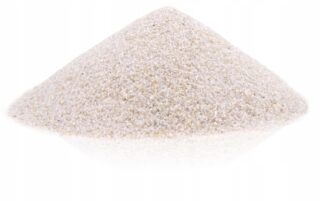
In large reservoirs, they are mounted in a separate room, and for private ones they are placed near the edge of the reservoir.
Manufacturing process:
- preparation of a tank for sand;
- installation of a pressure gauge;
- installation of a 6-position valve;
- connection of pump hoses.
After assembly work, sand is poured. Combined options work effectively. The sand is laid in several layers, each of which is represented by a certain fraction.
Sometimes several types fall asleep:
- anthracite;
- gravel;
- sand.
Quartz sand works 2 - 3 years, glass - 2 - 3 years longer. For a homemade device, they take loose, whitish sand with polished edges so that the mass does not crumple or stick together.
It is impossible to replace it with hot faceted sand from the river bank. The quartz filler is changed with glass grains of sand. They catch 30% more pollution, moss does not grow in the mass, and fungi do not develop. Such a filter is filled with 20% less volume than a quartz filter, and it lasts longer.
Device models differ in size and power, so the amount of filler for all types is different. The average weight is 40 - 280 kg.
User's manual
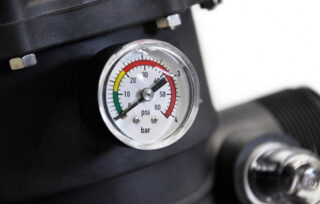
The units can be immersed, hung, placed on the surface. The quality of the collection of mechanical particles is an indicator of correct installation. Mount the filter so as to avoid dead spots where liquid does not enter the purifier.
Be sure to follow the safety regulations. When adjusting the 6-way valve, the pump is turned off.
Other rules:
- the device is mounted at least 1 meter from the walls of the pool;
- provide access to water streams in the installation area;
- selection and verification of the operating mode is done with the pump off;
- when switching the valve to another position, make sure that the lever coincides with the recess.
Do not switch the valve under pressure.
Include a pump to move water into the first filter through skimmers and drains. After cleaning, the liquid flows back into the total mass of water in the reservoir. Monitor the pressure gauge readings. Some filters have automatic cleaning, for which they relieve pressure in the system and transfer the valve to the cleaning schedule.
Sand flushing and replacement
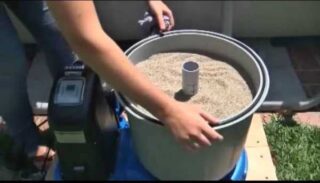
If there is no automatic cleaning, the work is done manually.The device is turned off, the valve is placed in the flushing position. The device is turned on for 5 - 6 minutes, turned off. The valve is placed in the tamping mode, turned on for 1 minute. The final step is to return the valve to filtering mode.
A clogged filter will be signaled by a pressure gauge. Clogged sand reduces the flow of water, but the head remains the same. Therefore, the pressure gauge will indicate an increase in operating pressure. It is required to turn on the flush mode to delay the replacement of sand.
The filling in private reservoirs is changed after 2 - 3 years, and in public ones it is carried out every year. The color, clarity and smell of water also testifies to the uselessness of sand.
To change the sand, the device is disconnected from the electricity, the taps are closed, the device is disconnected. After removing the plug, remove the sand; for this, use a vacuum cleaner. Nozzles require flushing to remove dirt. The container is filled with water to protect the structure from falling sand.
Fill with sand, screw the lid tightly. The next step is to backwash the purifier in a water-filled pond. Then include a light flush. The device is switched to filtration mode with the pump turned off, then the pressure is applied.

